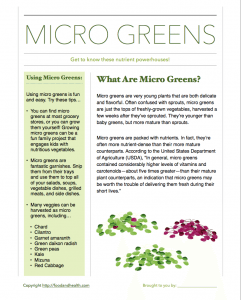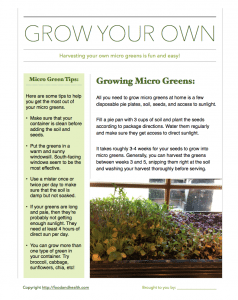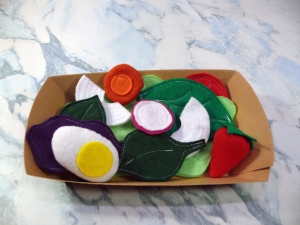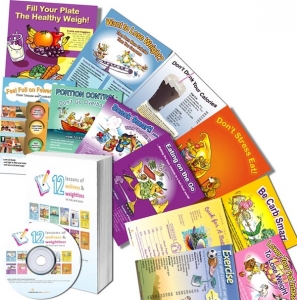Micro Greens 101
Have you ever heard of micro greens? Micro greens are very young plants that are both delicate and flavorful. Often confused with sprouts, micro greens are just the tops of freshly-grown vegetables, harvested a few weeks after they've sprouted. They're younger than baby greens, but more mature than sprouts.I recently visited a kitchen that was growing micro greens -- here's what I learned.They're tasty. I was blown away by the flavor that these little greens could add to any dish. The kitchen I visited harvested their greens once they'd reached the size of a leaf of flat leaf parsley, snipping the leaves and top of the stem from the root.They're versatile. Many veggies can be harvested as micro greens, but the ones I saw included...
Micro greens are very young plants that are both delicate and flavorful. Often confused with sprouts, micro greens are just the tops of freshly-grown vegetables, harvested a few weeks after they've sprouted. They're younger than baby greens, but more mature than sprouts.I recently visited a kitchen that was growing micro greens -- here's what I learned.They're tasty. I was blown away by the flavor that these little greens could add to any dish. The kitchen I visited harvested their greens once they'd reached the size of a leaf of flat leaf parsley, snipping the leaves and top of the stem from the root.They're versatile. Many veggies can be harvested as micro greens, but the ones I saw included...
- Chard
- Lacinato kale
- Curly kale
- Green peas
- Mizuna
 They're fantastic garnishes. Snip them from their trays and use them to top all of your salads, soups, vegetable dishes, grilled meats, and side dishes. Depending on what greens you grow, you can get sweet, spicy, bitter, or mild flavors from your micro greens. Play around to find which greens are tastiest in your kitchen.They're nutritious. Micro greens are packed with nutrients. In fact, they're often more nutrient-dense than their more mature counterparts. According to the United States Department of Agriculture (USDA),
They're fantastic garnishes. Snip them from their trays and use them to top all of your salads, soups, vegetable dishes, grilled meats, and side dishes. Depending on what greens you grow, you can get sweet, spicy, bitter, or mild flavors from your micro greens. Play around to find which greens are tastiest in your kitchen.They're nutritious. Micro greens are packed with nutrients. In fact, they're often more nutrient-dense than their more mature counterparts. According to the United States Department of Agriculture (USDA),
"Among the 25 micro greens tested, red cabbage, cilantro, garnet amaranth, and green daikon radish had the highest concentrations of vitamin C, carotenoids, vitamin K, and vitamin E, respectively. In general, micro greens contained considerably higher levels of vitamins and carotenoids—about five times greater—than their mature plant counterparts, an indication that micro greens may be worth the trouble of delivering them fresh during their short lives."
You can find micro greens at most grocery stores, or you can grow them yourself! Growing micro greens can be a fun family project that engages kids with nutritious vegetables. I personally found that my son was more interested in eating new foods when he had a role in growing them himself.To share this information with your clients, consider getting your very own copy of this free handout. It's in PDF format, which makes it easy to print, email, or post in a bulletin board. And, if you're a member, you can also access a step-by-step guide for growing and harvesting your very own micro greens. This guide is full of tips, tricks, and even a free handout!
And, if you're a member, you can also access a step-by-step guide for growing and harvesting your very own micro greens. This guide is full of tips, tricks, and even a free handout! Looking for other ways to get kids interested in healthy foods? Check out these fantastic resources...
Looking for other ways to get kids interested in healthy foods? Check out these fantastic resources...




